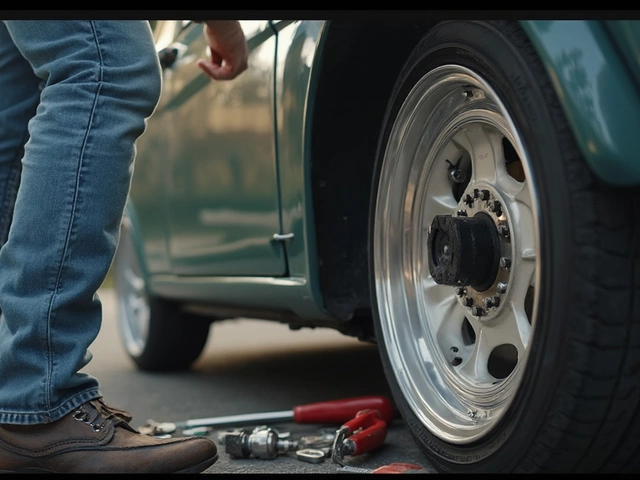When the unfortunate flat tire occurs, many drivers turn to the trusty spacer wheel—often called a 'donut'—tucked away in their trunk. It's a savior of sorts, offering a way to get back on the road swiftly. But questions often arise: just how far can you drive on a spacer wheel, and what should you be aware of?
Spacer wheels serve a temporary purpose, and it's critical to understand their limitations to maintain safety and avoid further vehicle damage. Insights into their design and function can help illuminate why they aren't meant for long journeys. Recognizing the factors influencing their performance, such as speed and road conditions, is key.
Let's explore the practical tips and interesting facts that can guide you when you're relying on a spacer wheel, ensuring you're prepared and knowledgeable next time you need to use this handy tool. Understanding when and how to transition back to a standard tire is integral for maintaining your car’s longevity and your peace of mind on the road.
- Understanding Spacer Wheels
- Distance Limitations
- Safety Considerations
- Factors Affecting Performance
- Practical Tips for Driving
- When to Replace Your Regular Tire
Understanding Spacer Wheels
Spacer wheels, known colloquially as 'donuts,' play a surprisingly quiet yet indispensable role for many motorists. These compact, temporary tires are essential for get-you-home or to-the-garage situations when a full-size spare is not immediately available or feasible. They are much narrower and lighter than regular tires, which makes them easier to store and carry in the confines of your vehicle’s trunk. Crafted for emergencies, a spacer wheel is not designed for comfort over long distances but purely to provide a functional, tactical solution during short, immediate needs. This utility is crucial, especially when a sudden flat tire threatens to disrupt the day's plans.
It's important to understand that spacer wheels have very specific limitations. Most are designed to be driven at speeds no greater than 50 miles per hour, and typically they are rated for a maximum distance of around 50 to 70 miles, depending on the manufacturer's recommendations. This is because spacer wheels aren't constructed with the robust design features of regular tires, such as enhanced tread patterns or sidewall strength. Instead, they focus on being lightweight and easily fitted. These limitations are part of a broader safety strategy, reminding drivers to replace them with regular tires as soon as practical. In the words of automotive expert James Morrison,
"A spacer wheel is a lifesaver, not a long-hauler. Use it to reach the nearest safe place, not for an extended road trip."
Examining the structural differences sheds light on why wheel spacers should not be over-relied upon. The thin tread and limited surface area of a spacer tire mean less grip on the road, which can affect vehicle handling, especially during adverse weather conditions. These tires typically lack the reinforced sidewalls present in full-size tires, which not only affects their durability but also the ride quality. Moreover, due to their construction, driving with a spacer wheel may lead to a slight imbalance in the car’s handling dynamics, emphasizing the temporary nature of their use.
Moreover, using spacer wheels correctly is an integral piece of car maintenance wisdom. When deployed, they should be paired with increased vigilance regarding vehicle control and road conditions. Drivers should avoid sudden maneuvers, as the reduced traction and stability can exacerbate issues during emergency braking or abrupt steering. Regular checks for proper inflation are also critical because any additional tire pressure loss can result in compromised performance and safety. Understanding these aspects will empower drivers to utilize spacer wheels safely and effectively.
Key Facts About Spacer Wheels
A closer look at industry data reveals that approximately 50% of all new vehicles sold in certain regions come equipped solely with a spacer wheel instead of a full-size spare, driven by manufacturers' desire to reduce vehicle weight and improve fuel efficiency. This trend underscores the necessity of understanding spacer wheels, as their prominence on the road increases. Drivers should be equipped with the knowledge of their usage and limitations to ensure safe and efficient travel, even in unexpected scenarios. Equipping oneself with emergency items such as a toolkit for quick installation and an easy-to-read manual can make the situation more manageable when a tire swap becomes unavoidable.
To sum up, while a spacer wheel is an indispensable tool in a driver's arsenal, it's not a substitute for a full tire. Grasping its intended use and constraints will help ensure you stay safe on the road. Keeping a keen eye on mile limits, speed regulations, and timely replacements can prevent mishaps and keep your journey as smooth as possible, even when faced with a tire obstacle.
Distance Limitations
When it comes to spacer wheels, understanding how far you can safely drive is essential. These wheels are not designed for extended use and are primarily intended to provide temporary mobility. On average, most vehicle manufacturers recommend driving no more than 50 to 70 miles on a spacer wheel. This limitation is set to ensure that the integrity of your car's handling and performance remains intact during use.
Spacer wheels are smaller and lighter, lacking the durability and features of a regular tire. They are optimized for temporary use, which means continued high-speed driving or covering long distances can lead to instability and increased safety risks. The reduced tread on a spacer wheel also compromises the vehicle's ability to grip the road adequately, especially in adverse weather conditions. What was designed as a stop-gap solution can become hazardous if utilized for longer than intended.
According to the National Highway Traffic Safety Administration, 'Driving on a temporary spare tire for longer than recommended can lead to accidents due to reduced road grip and handling capabilities.'Spacer wheels are also limited to certain speed tolerances. Manufacturers commonly advise against exceeding 50 miles per hour. Exceeding these speeds can lead to increased tire wear and affect the car's suspension system, creating a dangerous driving environment. Sustained use beyond these parameters not only endangers the driver and occupants but can also lead to costly damages.
It's crucial to plan accordingly when a spacer wheel is in use. Calculate the nearest service station or tire repair shop within the suggested driving range. If your destination exceeds the recommended mileage, it's advisable to have a tire service come to your location rather than risk safety by pushing the limits of the spare. Some drivers keep a note in their glove box with local tire services' numbers, which might come in handy during such an emergency situation. Remember, the goal is to use the spacer wheel for as short a time and distance as possible, serving as a bridge to proper tire replacement.
Determining whether driving conditions like rain or snow are present is also critical, as these conditions can further shorten the safe usage distance of your spacer wheel. Under such scenarios, traction is further reduced, and the likelihood of sliding increases, emphasizing why it's crucial not to prolong the use of a spacer. If conditions are poor, ensuring a position to quickly switch back to a full tire should be a priority. Having the necessary tools and knowledge can significantly help in such instances, sparing you some unwelcome roadside emergencies.

Safety Considerations
Driving on a spacer wheel introduces unique safety challenges that demand attention and understanding. These compact and lightweight alternatives to full-sized tires are designed for brief, emergency use only. This means, quite critically, that their construction limits both speed and distance. One key consideration is the impact on vehicle handling; spacer wheels are narrower and often have different tread patterns compared to regular tires, which can affect steering responsiveness and traction, particularly in adverse weather conditions like rain or snow.
Another aspect to be mindful of is the effect on braking distance. Because a spacer wheel offers less contact with the road surface, stopping distances may increase. It's advisable to adjust driving habits accordingly, including maintaining greater distance between vehicles and reducing speed. Common guidelines suggest not exceeding 50 miles per hour when driving on a spacer wheel, and ideally, it should not be used for distances greater than 70 miles. Against this backdrop, regular tire maintenance, such as checking air pressure and wearing patterns, becomes crucial for preventing the necessity of using a spacer.
It's important to consider load limits when relying on a spacer wheel. These wheels are typically not intended to bear the vehicle's full load capacity. Drivers should avoid carrying heavy loads during their operation, which could otherwise lead to wheel damage or even a blowout. Equally important is the immediate replacement of a faulty tire; postponing this can not only exacerbate the wear and tear on the spare but also endanger the driver and passengers. As the renowned automotive consultant, John Davis, once noted, "A spare wheel is never a substitute but merely a stopgap, a temporary bridge to get you to a safer, more secure solution."
"A spare wheel is never a substitute but merely a stopgap, a temporary bridge to get you to a safer, more secure solution." - John Davis
Aligning the vehicle's center of gravity is another concern with spacer wheels, potentially leading to imbalanced weight distribution, which could destabilize the car, especially during cornering or abrupt maneuvers. Drivers should be conscious of uneven feedback when handling their vehicles under such conditions. Moreover, the usage of any spacer requires a careful examination to ensure that the wheel nuts are correctly torqued, as improper installation can lead to accidents. Paying close attention to these fundamental safety measures not only ensures a smoother driving experience but significantly reduces the likelihood of sudden mechanical failures. Understanding these safety considerations extends the operational life of your vehicle and secures the safety of everyone on the road.
Factors Affecting Performance
Driving on a spacer wheel may seem straightforward, especially when you're in a bind and need to reach the nearest service station. However, a series of factors critically affects how well a spacer wheel performs and how safely you can rely on it during your journey. One pivotal factor is the speed at which you're driving. Spacer wheels are often smaller and narrower than regular tires and are designed for limited speeds, generally not exceeding 50 mph. Exceeding this speed can lead to loss of vehicle balance and control, increasing the risk of accidents. Another key factor is the weight load the vehicle carries. Spacer wheels are typically engineered for reduced loads compared to regular tires, so overloading the vehicle can stress the wheel beyond its capacity, leading to premature wear or even catastrophic failure.
The condition of the road significantly influences the performance of your wheel spacers. Smooth roads might not present a problem, but uneven surfaces, potholes, or gravel roads place undue stress on the spacer wheel. Rougher terrains can cause additional wear to the tire and wheel assembly, and prolonged use in these conditions is not advisable. Additionally, weather conditions play a crucial role. Spacer wheels may not provide the same traction or stability as regular tires under wet or icy conditions. Tire pressure is another factor that cannot be overlooked; maintaining proper air pressure in your spacer wheel is necessary to avoid degradation or a blowout. An often-overlooked factor is vehicle alignment; a spacer wheel can alter the alignment slightly due to its different size and weight distribution, affecting handling and driving comfort.
"Understanding the limitations of a spacer wheel is fundamental for any driver. Keep in mind these temporary wheels are not designed with endurance in mind; they are a stopgap measure to allow you to seek professional assistance," - states tire expert John Mitchell from Auto Safety Magazine.
Regular car maintenance checks can detect issues with suspension and alignment that could influence spacer wheel performance. Keeping the spacer wheel clean and free of debris can also help ensure added longevity during its limited use. In some situations, the law may also dictate specific usage limits on spacer wheels, and these regulations could vary by region, so familiarity with local guidelines is beneficial. It's clear that spacer wheels have their place in ensuring mobility during emergencies, but the factors affecting their performance mean that users need to exercise caution and be prepared to adapt their driving for the safest outcome. Drivers who are aware of these factors can better mitigate risks, ensuring their vehicle, passengers, and other road users remain safe.
| Factor | Impact on Performance |
|---|---|
| Speed | Should not exceed 50 mph to avoid instability. |
| Weight Load | Limit excess loading to prevent tire stress. |
| Road Condition | Smooth roads preferred; rough and uneven surfaces can be problematic. |
| Weather | Performance diminishes in wet and icy conditions. |
| Tire Pressure | Maintain optimal pressure to prevent blowouts. |

Practical Tips for Driving
When relying on a spacer wheel after a flat tire incident, it's essential to adopt a driving style that maximizes your safety and prolongs the lifespan of this temporary solution. First and foremost, reducing your speed is crucial. Most spacer wheels are not designed to handle speeds beyond 50 mph (80 km/h). Maintaining a conservative speed not only ensures your safety but also helps to preserve the integrity of the wheel spacer. It's worth noting that the spacer wheel's reduced traction and stability compared to regular tires can affect your vehicle's handling, particularly in adverse weather conditions.
Another critical tip is to monitor the distance you're covering with your spacer wheel. Typically, the advised limit for driving on a spacer wheel is between 50 to 100 miles. Pushing beyond this range can increase the risk of tire damage and even lead to dangerous blowouts. The limited tread on these wheels means they wear out much faster, and prolonged use can exacerbate this issue. Always aim to replace the temporary fix with a standard tire as soon as possible to restore your car's full performance capabilities.
Maintaining awareness of your steering and braking is also vital when using a spacer wheel. Due to the differing sizes and performance capabilities between your standard tires and a spacer wheel, you may notice a pull in your steering or a longer braking distance. Compensating for this by allowing for additional stopping space and avoiding sharp turns can prevent potential mishaps. Regular checks on the wheel spacer’s air pressure are also recommended, as proper inflation pressures are necessary to support the limited load they are designed to handle.
Beyond the basics, consider the terrain you'll be navigating with the spacer wheel. Ideally, stick to paved roads and avoid rough terrain or off-roading. The undersized nature of these wheels makes them ill-suited for uneven or loose surfaces, where the risk of losing control is significantly heightened. In urban environments, avoid high-traffic areas where sudden stops and quick maneuvers are commonplace, as they can test the limits of your spacer wheel's performance. If long-distance travel is unavoidable, consider alternatives such as towing your vehicle to a service center.
Talking of alternatives, it's good practice to keep a close eye on your full-size spare's condition if you have one. Regular maintenance checks, including rebalancing and pressure checks, ensure it's ready in case you need a more durable spare. Investing in a roadside assistance plan can also provide peace of mind, typically offering a more reliable option than pushing a temporary spacer wheel beyond its limits. Keeping these practical tips in mind can significantly affect the safety and success of your interim driving journey.
A noteworthy reminder comes from the National Highway Traffic Safety Administration (NHTSA), which advises,
"Temporary use tires have a significantly shorter tread life and should only be used for very short time periods and distances."This serves as a crucial reminder of the intended purpose of these tools. A thorough understanding of these guidelines ensures you and your vehicle remain secure until you make that inevitable return to standard tires. The journey with a spacer wheel is one that requires caution and prompt action towards restoration to full driving readiness.
When to Replace Your Regular Tire
Knowing the right time to replace your regular tire is crucial for safety and vehicle performance. Modern tires are marvels of engineering, designed to grip the road in all sorts of conditions. However, their efficiency dwindles as they age. The general recommendation is to replace tires every six to ten years, regardless of mileage, but there are several indicators that might prompt an earlier change. One key signal is tread depth—the grooves in a tire. When the tread depth falls below 2/32 of an inch, the tire's ability to grip the road significantly diminishes, affecting stopping distances and increasing the risk of hydroplaning. A simple way to check your tread is the penny test: insert a penny into the tread with Lincoln's head upside down. If you can see the top of his head, it's time for a new tire.
Another factor to consider is age. Even if the tires look fine and have ample tread left, the rubber compounds degrade over time. Most manufacturers suggest tire replacement after six to ten years, regardless of tread wear. This is especially important if the tires are used in harsh conditions. Visual inspections should also be regular practice. Look for cracks or bulges in the sidewall, which can indicate structural weaknesses. During such checks, pay attention to any punctures or embedded objects that could potentially cause slow leaks or sudden air loss.
Driving habits also play a pivotal role in tire longevity. Aggressive cornering, sudden stops, and frequent speed changes can accelerate tread wear. If you often drive on poorly maintained roads or face extreme weather conditions, your tires might need replacing sooner. Additionally, rotations and alignment checks are recommended every 5,000 to 8,000 miles to ensure even wear and prolong tire life. It's also wise to consult your vehicle’s manual for manufacturer-specific guidelines, as they fine-tune their advice based on the car's design and performance capabilities.
According to expert guidance from the National Highway Traffic Safety Administration (NHTSA), 'All tires—including spare tires and tires on older vehicles that are driven only occasionally—should be replaced when they reach six years, regardless of how many miles have been driven.'This serves as a guideline for moving beyond appearances and trusting expert advice for safety.
Finally, considering the spacer wheel downtime preference, once mounted, ensure that a timely decision on replacing the regular tire is made. There's no substitute for professional advice, so when in doubt, consult a tire specialist to assess the health of your tires accurately. They can provide insights that aren't immediately visible, such as the internal condition and any potential mismatches in tire or wheel alignment. Being proactive about tire health helps avoid emergencies, ensuring a secure and smooth driving experience.




